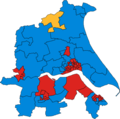History
Humberside was a non-metropolitan county governed by Humberside County Council and nine non-metropolitan district councils. The county council came into its powers on 1 April 1974 and was abolished in 1996. [1] The county council was based at County Hall in Beverley. [2] On 1 April 1996 the county council was replaced with four unitary authorities: North Lincolnshire, North East Lincolnshire, Kingston upon Hull and East Riding of Yorkshire. [1]
The coat of arms was submitted to the council for approval by a resident of Humberside (in Thorngumbald), and depicts several characters in the blazon. The shield bears two Yorkshire roses, a pair of gold fleur-de-lys for Lincolnshire and a gold ducet for Hull. The crest depicts a blue eagle issuing from the old East Riding arms - an allusion of the new deriving from the old. The eagles has droplets on its wings, representing North Sea oil. A sword represents Scunthorpe steel, with a dolphin, anchor, waves and globe representing the docks and shipping of the Humber, and the goddess Ceres represents agriculture. [3]
This page is based on this
Wikipedia article Text is available under the
CC BY-SA 4.0 license; additional terms may apply.
Images, videos and audio are available under their respective licenses.


